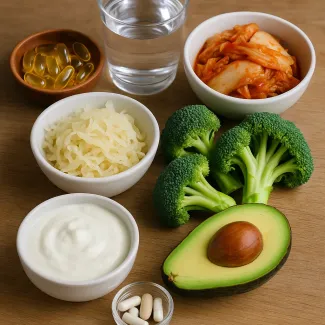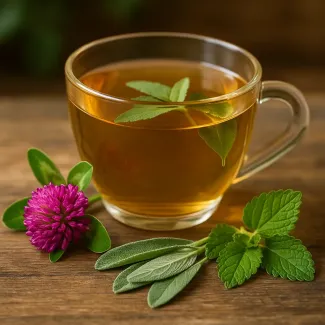
Calming Your Mind Naturally After 50: Daily Practices That Truly Work
Rediscovering inner peace during life’s most transformative decade
Turning 50 often brings a new perspective on health, priorities, and emotional well-being. While many embrace the freedom that comes with age, others find themselves dealing with unexpected stress and anxiety. Hormonal shifts, lifestyle changes, and increased responsibilities can weigh heavily on your nervous system, making it harder to maintain calm and focus. That’s why learning to naturally regulate your stress response after 50 is essential—not only for mental clarity, but for overall longevity.
This article explores in depth natural and proven methods to reduce stress, calm the nervous system, and restore emotional balance in your 50s. From breathwork and gentle movement to sensory practices and sleep hygiene, these techniques are designed to meet the evolving needs of your body and mind during this life stage.
Why stress feels different in your 50s
During your 50s, your body undergoes significant biological and hormonal transitions. For women, this often means navigating perimenopause and menopause, both of which are closely tied to fluctuations in cortisol levels. For men, testosterone declines gradually, often impacting emotional stability, sleep, and focus. These hormonal shifts can amplify your reaction to stress, reduce your natural resilience, and trigger feelings of unease.
At the same time, your life structure may be changing. Many face aging parents, empty nests, career transitions, or even early retirement planning. These factors combine to create a psychological environment ripe for chronic tension, irritability, and sleep disturbances. That’s why stress relief in this decade needs to go beyond the occasional massage—it needs to become a daily ritual.
The breath-body connection: training your nervous system to relax
Diaphragmatic breathing
Learning how to breathe deeply and intentionally is one of the most accessible and powerful ways to reduce daily tension. Diaphragmatic breathing stimulates the vagus nerve, which in turn activates the parasympathetic nervous system—your body’s natural relaxation mode. Practicing just 5 minutes of this technique per day can lower your heart rate, improve digestion, and reduce cortisol levels.
Box breathing for mental clarity
Box breathing, a method involving equal counts of inhale, hold, exhale, and pause, is often used by elite performers and therapists to center the mind. In your 50s, it’s especially useful to reduce mental chatter, calm racing thoughts, and improve emotional regulation. Try practicing box breathing before bed or during breaks to recalibrate your inner balance.
Alternate nostril breathing
This yogic technique is known to balance hemispheric brain activity and stabilize mood swings. If you find yourself more emotionally reactive, especially during hormonal changes, alternate nostril breathing can bring calm and coherence in just a few minutes.
Movement that calms: low-impact activities for body and mind
Walking meditation
Combining gentle movement with mindfulness, walking meditation is ideal for those over 50. It improves circulation, supports joint health, and keeps your nervous system grounded. Focus on each step, the sensation in your feet, or the rhythm of your breath as you walk. Even 15 minutes a day can be profoundly calming.
Qi Gong and Tai Chi
These traditional Chinese practices blend slow movement, breath, and intention, offering the perfect combination of exercise and mental relaxation. Both practices have been shown to reduce anxiety, improve balance, and increase energy levels in people over 50. They’re especially beneficial for those managing chronic tension or age-related stiffness.
Restorative yoga
Unlike active yoga styles, restorative yoga involves supported poses held for longer durations, often using props like bolsters and blankets. This promotes deep muscular release, reduces nervous system arousal, and fosters a profound sense of safety in the body—essential for those struggling with inner restlessness or persistent muscle tension.
Sleep hygiene as stress prevention
Sleep is a cornerstone of emotional well-being. Yet, in your 50s, hormonal changes often disrupt sleep, leading to increased night waking, difficulty falling asleep, or early-morning anxiety. Creating a personalized wind-down ritual is key to reestablishing restful sleep patterns.
Light exposure and melatonin rhythms
Spending time in natural light early in the day helps recalibrate your circadian rhythm. This regulates melatonin production, which is often out of sync in adults over 50 due to screen exposure, indoor lifestyles, or hormonal shifts. Aim for 20 minutes of sunlight before 10 a.m. and limit blue light exposure after sunset.
Evening rituals to signal safety
Design your own evening transition that helps signal safety to your nervous system. This might include a warm shower, stretching routine, calming tea, and time away from screens. The goal is to tell your body: “It’s time to rest.” Over time, these rituals form neural associations that lead to easier, deeper sleep.
Limiting stimulants and triggers
Caffeine, alcohol, and late-night news consumption can all heighten sympathetic nervous system activity, making it harder to relax at night. Switching to herbal drinks, limiting screen time, and avoiding intense conversations in the evening can have an outsized impact on your sleep quality.
The healing power of touch and connection
Self-massage and acupressure
Gentle self-massage techniques, especially on the feet, neck, and shoulders, help release held tension. Acupressure points such as Pericardium 6 (on the inner forearm) and Yin Tang (between the eyebrows) are known to reduce anxiety and promote calm.
Safe human contact
Oxytocin, sometimes called the “calm hormone,” is released through nurturing touch. Regular hugs, holding hands, or even cuddling with a pet can activate your body’s relaxation pathways, boosting resilience and reducing the sensation of isolation.
Therapies that work with touch
Consider booking craniosacral therapy, reiki, or gentle fascia work. These therapies emphasize subtle movement and alignment to bring the nervous system into a state of ease, often relieving long-held stress patterns without invasive techniques.
Sound, scent, and environment: calming your senses
Nature sounds and white noise
Auditory environments significantly affect your baseline stress level. For those in noisy or busy homes, white noise or natural soundscapes (like rain, ocean waves, or birdsong) can create a protective auditory buffer that improves focus and emotional steadiness.
Aromatherapy for hormonal balance
Essential oils such as lavender, clary sage, and frankincense have been used for centuries to modulate stress responses. In your 50s, they may also support hormonal harmony. Diffuse calming oils in the evening or apply a diluted blend to pulse points for a portable calming effect.
Environmental order and calm
A cluttered environment can signal danger to the nervous system. By curating a peaceful space, especially in your bedroom or personal corner, you give your body visual cues of safety and control, which can lower background tension and improve mood.
Nutrition and supplements that support calm
Blood sugar regulation and mood
Fluctuating blood sugar levels can significantly impact your emotional stability. Eating balanced meals with protein, fiber, and healthy fats helps avoid the mood dips that follow sugar crashes. Stable blood sugar promotes stable moods.
Magnesium and stress resilience
Magnesium is a critical mineral for nervous system regulation, especially in the face of daily stress. It helps relax muscles, supports sleep quality, and modulates the stress hormone cortisol. Consider magnesium-rich foods or a gentle supplement before bed.
Adaptogens for hormonal support
Plants like ashwagandha, rhodiola, and holy basil are known for their ability to support stress resilience and hormonal balance. These can be helpful in managing the physiological stress load that often accumulates in midlife.
Mindfulness without meditation: focus techniques for the modern adult
Single-tasking and intentional focus
Multitasking increases mental clutter. Practicing intentional focus on one task at a time not only improves productivity but also reduces the subtle anxiety of divided attention. Whether it’s washing dishes, writing, or folding laundry—be all there.
Gratitude and sensory anchoring
Start or end your day by listing three things you’re grateful for. This simple practice rewires your brain toward positive emotional states and shifts attention away from perceived threats. Pair this with sensory awareness—what you feel, see, hear, and smell—to ground yourself in the present.
Gentle observation
Rather than trying to stop your thoughts, simply observe them with curiosity. This practice of nonjudgmental observation reduces resistance, lowers emotional reactivity, and strengthens emotional maturity—key in navigating this transformative life stage.
Rituals that anchor your nervous system
Morning grounding
Begin your day with a non-negotiable grounding practice—this could be a barefoot walk, a warm drink sipped slowly, or a few gentle stretches. These small habits help set the tone of calm resilience for the day ahead.
Midday resets
Around noon or early afternoon, take a pause. Step outside, breathe slowly, or close your eyes for 3 minutes. These micro-breaks interrupt the accumulation of tension and prevent emotional burnout by evening.
End-of-day reflection
In the last 30 minutes before sleep, give yourself digital silence, dim lighting, and a self-soothing ritual such as journaling or self-massage. These cues help deactivate your stress response and signal readiness for restorative rest.
Emotional freedom techniques and cognitive tools
EFT tapping
This technique involves tapping on meridian points while verbalizing emotions, helping to release fear, anger, or sadness stored in the body. It’s especially helpful during transitional life periods, when emotional clarity can feel hard to reach.
Reframing and inner language
How you talk to yourself matters. Instead of “I can’t handle this,” try “I’m doing the best I can right now.” This shift in internal narrative directly influences your nervous system’s threat perception and enhances emotional flexibility.
Digital boundaries
Managing media consumption is critical in your 50s, when your nervous system may be more sensitive to overstimulation. Unfollow accounts that induce stress, avoid doomscrolling, and curate your digital input to protect your peace.
Hormonal awareness and emotional rhythm
Listening to your internal clock
Many in their 50s experience cyclical emotional patterns that correspond with hormonal tides. By tracking your emotional rhythms, you begin to recognize predictable waves of vulnerability and strength, allowing better self-compassion and planning.
Supporting estrogen and progesterone naturally
For women, nourishing the body with healthy fats, B-vitamins, and zinc can support smoother hormonal transitions. For men, supporting testosterone through strength training and restful sleep can significantly boost confidence and emotional balance.
Acceptance of emotional shifts
Rather than resisting emotional fluctuations, embracing their presence with curiosity helps reduce their intensity. Emotions are not enemies—they’re messengers asking for attention. Acknowledging them can be the key to deep and lasting calm.
Cultivating calm is a daily art
In your 50s, relaxation is not a luxury—it’s a necessity. The techniques shared here are not about escaping reality, but about creating intentional, embodied rituals that support your nervous system, emotional clarity, and sense of joy. Whether you begin with just five minutes of breathwork or a dedicated daily grounding ritual, these small practices build upon one another to create a life that feels calm, stable, and deeply nourishing.


